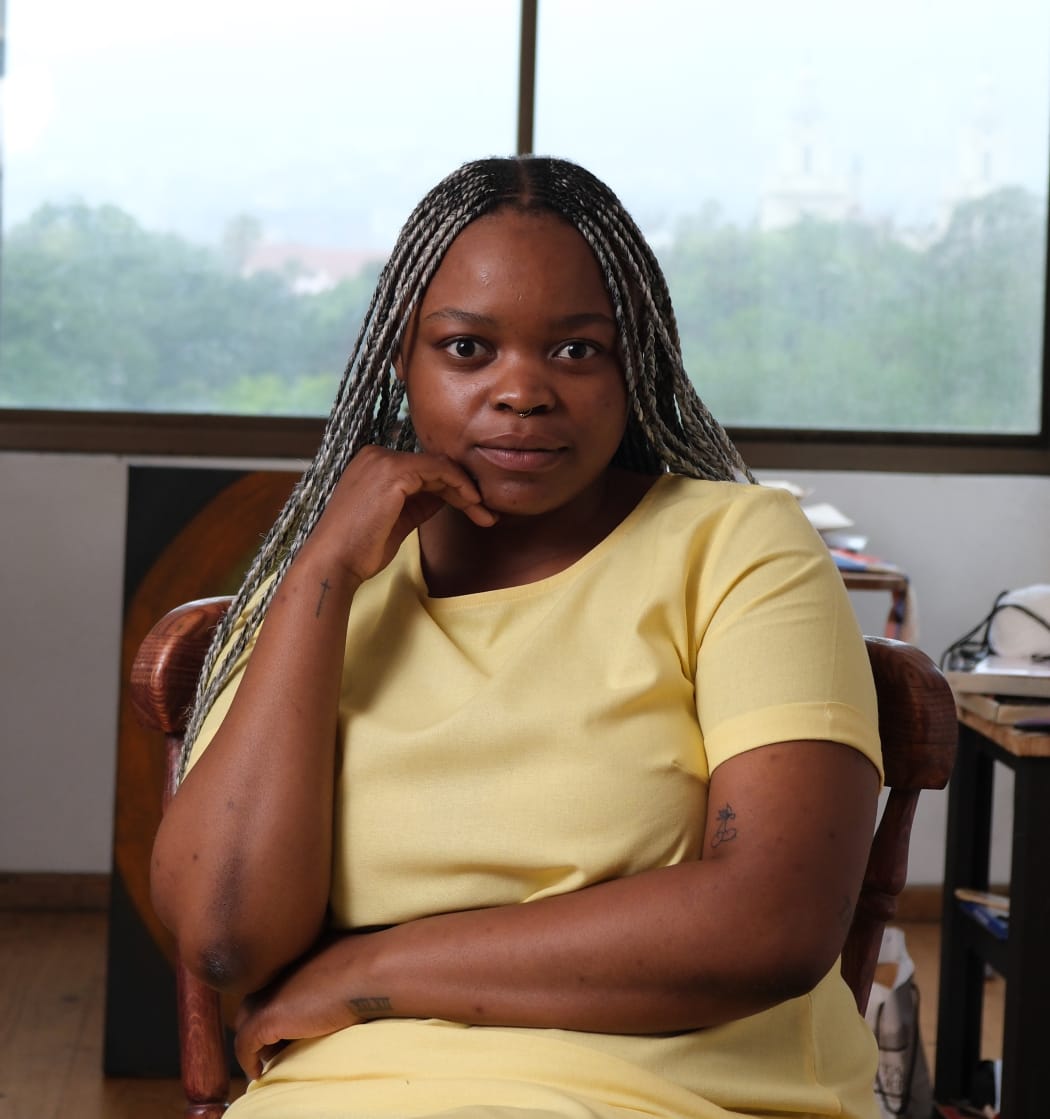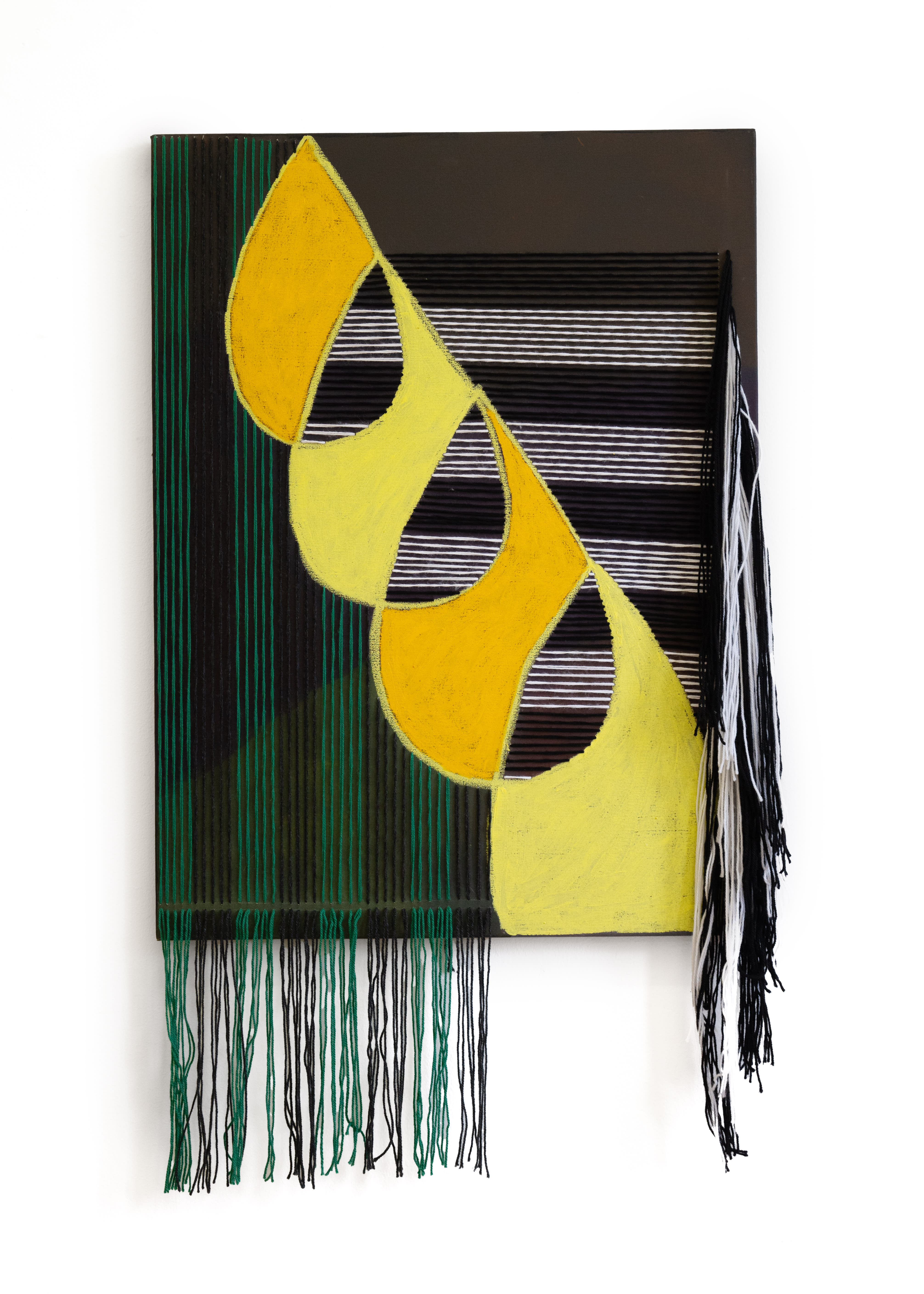
Could you start by introducing yourself and sharing a bit about what you’ve been working on recently?
I’m Khanyi Mawhayi. I'm an artist and curator. I was born in Johannesburg, but I’m living in Cape Town. Currently, my work is thinking about grief for the living and the dead, loss, and how to process that since I've lost many people this past year. A big question for me revolves around desire and dignity as well. Do you have to give up dignity to get your desires? Are they dignified ways of getting your desires? That's where my headspace is at in terms of studio work.
About the dignity in desire, do you mean the effort to not lose yourself while you're trying to have something you crave?
Exactly. All of these desires that we have require a certain amount of vulnerability. The vulnerability to claim that desire firstly and then to attempt to get it. Through this attempt, you have to accept you may not be successful. When you're not successful in getting that desire, it can often feel undignified, whereas through success, the process accesses a certain dignity, and being vulnerable is then celebrated. It's a new thought in my mind that I'm trying to work through in the studio.
You are an artist who also works as a curatorial assistant at the Zeitz Museum of Contemporary Art Africa. Does this role influence the way you think about or approach your own artistic practice?
I would say it definitely does. The ideas cultivated in the museum space significantly influence my artistic practice. I think being an artist makes me a better curator, and being a curator makes me a more empathetic artist towards other curators. I understand the stress that goes into making an exhibition, and I'm more generous towards exhibition makers because I'm an exhibition maker myself. I'm also more generous towards artists because I understand what it takes to be an artist and to bring something into the world out of nothing.
I'd say that this role definitely does feed into my art practice, and of course the incredible artists that I get to meet through my job are also very important to the development of my practice.
You master a wide range of artistic processes, including painting, photography, and printmaking. Which medium did you begin with in your artistic journey, and how has your relationship with different media evolved over time?
Drawing is generally the first medium of any artist, but my first solo exhibition was cyanotypes and drawings. I feel that the work decides what medium it'll be. It's very much intuition-based. The work always tells me what it needs. Some other times, I have materials that I’ve never used before, like cyanotype. The first time I used it, it was during COVID; we were getting cyanotype kits. I could see what I could do with this, and that's often how it evolves.
I wouldn't call myself a master, but I think each medium can achieve different things. So when I think about the video work, for example, it's very much like performance space. If I think about my drawings, they are trying to create something in the world that I haven't seen before.

You're totally free regarding which medium you use, and you don't limit yourself on how to make certain things; you have the idea before, and then you just try to make it.
Exactly, and I think as an artist, I'm not a perfectionist in that sense. I very much believe that the idea is perhaps most important. The medium offers what it can, but it always begins with the idea.
Is there a medium that particularly interests you but that you haven’t yet had the opportunity to explore?
I definitely want to work with glass. Glass needs to be fully understood to have a satisfying result; otherwise, it can end up feeling and looking very kitsch. That's my dream one day to make something out of glass!
Your work is notably colorful, often grounded in a recurring base of black and white that emphasizes the presence of vibrant hues. How intentional are your color choices, and what emotional or conceptual roles do they play in your work?
I don't know, I go to the shop, and I buy the colors that I want. Then I go into the studio, and I'm like, "Oh, this is all I have to work with; let me try to figure it out." My works are very abstract, but if I'm referencing trees or flowers, the color will come from the thing I'm referencing, and then it creates a feeling of its own. People have their own connotations about what certain colors mean. I think the black and white support and bring that out.
I also think color is a cultural thing. In the Tsonga culture, color blocking is very important, so you'll see in the traditional way that the color blocking is used quite intentionally. I feel like I'm just naturally attracted to color.

Khanyi Mawhayi, Waterfalls of the Sun (After Mary Oliver), 2025
Regarding color blocking, the majority of your latest work is based on single colors. There is not much of a color confrontation. I can think of one artwork where there's a rainbow, but I feel like recently your colors are more individualized.
Exactly, I think I've grown a different approach regarding colors. Living in Cape Town, a very much monochromatic city, has definitely influenced the way I see and use color. I think with the rainbow, for example, when I am referring to this, I'm talking about the LGBTQI+ flag. So it has to look like the thing it's referencing, or at least people must be able to read what I’m trying to put on the canvas. As the years have gone by, it's become a much more consolidated use of color.
You talked about how your current environment influences your artwork. Do you find other sources of inspiration?
I'm inspired a lot by poetry at the moment. I'm inspired by the things people say in conversations. My work is about identity formation, and I think conversations are such a big part of who we choose to be or how we choose to show up in the world. All in all, poetry and music are playing quite a big role in my practice right now. Song lyrics are like catalysts in my practice.
Is there any poem that moved you recently?
Mary Oliver and Ben Okri are two important inspirations at the moment for me. I love the way Mary Oliver takes the everyday and makes it so significant. Through what seems to be a basic life experience, such as taking a walk in the park, she always manages to reveal magnificent things. She's always in awe of the world. Being able to find the poetry in everyday things is what I'd like to do through my art.
Your recent works lean toward non-figurative forms, although in the past, imagery has played a significant role—for example, in Dela (Surrender) (2020). Could you tell us how your relationship with figurative imagery has evolved over time?
I've moved completely away from figuration. I don’t think I’ll never go back; I definitely will. In that particular series, my body had to be involved. Dela happened so unexpectedly. I think I was playing around at home with lights and my camera, and it just became such a significant image within that body of work.
I think with figuration, you need a clear idea of what it is you want to say. Because it's figurative, the viewer doesn't spend as much time trying to figure it out. They walk into it, and they want to know what it means immediately. Abstraction allows for a little more ambiguity; it opens up a space of possibilities that, perhaps, figuration doesn't offer for me.
What kind of attitude or engagement do you hope your audience brings when experiencing your work?
I hope they slow down firstly. That's my dream, to just slow people down. In an exhibition space, I hope it raises curiosities more than it answers questions. I hope that as they see the work, they also interrogate their own identities and the things that have formed those identities but also that they allow the work to maybe not change them but to challenge them.
Do you feel like while you're doing these artworks, you're slowing down too? Everything that you’ve said can be said for you as well?
Definitely! I think about the Black and White Paradise series; when I went into making it, I really thought that I could create a paradise for myself that was black and white, where I understood what the rules were and exactly how things are supposed to be. In the making, I started to appreciate the gray areas of life, the moments where color comes into life. Maybe you are living in a black and white paradise, but the color kind of shocks you back to life, almost like in The wizard of Oz.
I approach the work with so much assuredness of what it’s supposed to be, but by the time I finish a body of work, it has completely changed who I am or how I see the world.
The group exhibition Echoes of Repetitions marks your first presentation in a French gallery. How do you feel about this experience, and what do you hope to convey or discover within this new Parisian art landscape?
Thinking about my own experiences there, I hope that whoever comes to see the show and gets confronted with this idea of echoing repetition could have the opportunity to give things another chance. Paris is a very beautiful city, but a fast city as well. People are always in a rush, especially the cyclists. So, I would like to slow people down. What I mean by that is to take the time to take things in and try something again one more time even if it was painful the first time. See what happens the third time around or even the fourth time around. I'm looking for people to have a little more perseverance.
I don't know if my two little works can change the Parisian art landscape, but I hope that there's a better awareness of what's happening on the continent of Africa and how creativity and stories from this continent really is the future of the world.
